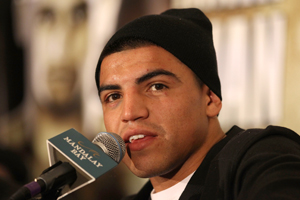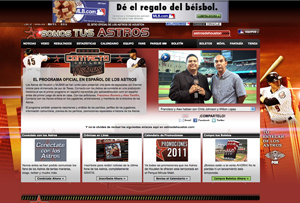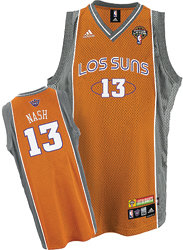■ Learn from athletes and their stories. Many 20-somethings who are emerging as stars are much like the cultural, bilingual audience. Boxer Victor Ortiz was born to Mexican immigrant parents in Garden City, Kan. He was raised
 |
Getty Images
Victor Ortiz |
mostly by Anglo foster parents in the Midwest. When he was 16, he moved to California to train. Soon after, he learned to surf. He is comfortable speaking English or Spanish, sometimes wears a sombrero into the ring, cheers loudly for the Kansas Jayhawks and drips a surfy-kind of California cool. Which box would you like to put him in?
“He has a personality that connects with everyone,” said Loretta Lucero, president of California-based Touch Point Marketing, which works with sponsors of Golden Boy Promotions. “He’s a cool surfer guy but he’s loyal to his Hispanic roots. He can sing with mariachis if he wants but also go surf with five guys off the Santa Barbara coast. That is the face. That’s the future.”
■ There is room in the basket for the familiar and the new. For years, MLS has wrestled to gain traction with Mexican Americans who followed soccer avidly, but paid little attention to what went on stateside. The league has found that its best chance is to seek inclusion, rather than conversion. “If your family soccer club was Cruz Azul and you live in Chicago, your family would get together and watch Cruz Azul,” said Russell Findlay, MLS CMO. “They would know when the games were on and support them endlessly and wear their colors. That doesn’t mean they can’t and won’t be supporters of the Chicago Fire. It doesn’t mean we want them to convert away from Cruz Azul. We want them to have a trial and adopt the local club.”
■ The future may be Spanish in English. “For now, people mostly think about Spanish language as a way to reach Spanish dominants, and around the right properties and the right athletes there is always going to be a business,” said Dario Brignole, a former IMG executive who now runs his own agency, Shine Entertainment, in Miami. “But bilingual, bicultural content, if you asked me, is the future. If I have $10 million to put in a new business, my business would be Latino sports content, but in English. That’s where I’d go.”
■ Use the Web to deliver original content that is relevant to bilinguals. This season, the Houston Astros launched a weekly Web series called “Contacto con los Astros,” which features the team’s Spanish-language radio crew hosting a
seven- to nine-minute segment that includes one interview with a player in Spanish and another in English, the latter of which includes Spanish subtitles. All webisodes are posted to both Spanish and English social media streams and also promoted through Univision. The Astros consider the core of their Hispanic market to be 18-34 and bilingual. “Showing our players speaking in their native tongue is invaluable,” said Astros Hispanic market development coordinator Nicky Patriarca. “Even if [fans are] English-speaking Hispanics, they’re still very interested in their culture.”
■ The smaller segments aren’t so small any more. The New York Mets know their Hispanic market is still mostly Caribbean and that’s where they place most bets. But now, they are broadening their attempts to attract Hispanics from nations where baseball is less popular. Later this month, Citi Field plays host to a soccer match between Club America of the Mexican Primera Division and Juventus of the Serie A Italian league. Mexicans now represent the third-largest segment of the Hispanic market in New York, at 12.4 percent. “We can have a new segment of the growing Latino population in the community come to Citi Field and experience how we provide service and see how welcoming we are,” said Dave Howard, executive vice president of business operations for the Mets. “Hopefully they’ll come back for baseball games.”
■ Hispanic is not a target. It’s many targets. Figure out which fits you and learn more. “Marketers are used to being lazy — and I’ll say that loud and clear,” said Chiqui Cartagena, vice president of corporate marketing for Univision. “They’re used to doing one big message that fits all. That hasn’t been working for at least 10 years. I have to define who my target is. More and more that opportunity to win and grow becomes very Hispanic. Do the homework, get the right insight, and then send a message — whether it’s in English or Spanish — that is culturally relevant.”
■ Think mobile and get social. You’ll see lots of discussion about Latinos overindexing on use of mobile devices and social networks. That’s true, but in pockets. Overall, Pew Hispanic Center research shows Hispanics are less likely than others to use the Internet or cellphones. Hispanics with more education are more similar to the general market in their digital usage. But that group — Latinos with high school diplomas or more — differs from others in the way they use their devices. They are less likely than others to have a home Internet connection and more likely to use their mobile device to access the Web and to text. Spanish Facebook and Twitter feeds are no-brainers.
■ Understand that aspects of your brand resonate across culture and language, and they may be powerful enough to transcend both. While the Yankees recognize the value some teams see in adding a Los on their jersey — Los Mets, Los Marlins, Los Suns — they say they have no intention of going that route. “Even I, the Latin affairs guy, don’t think that’s a good idea,” said Manny Garcia, the Yankees’ director of Latin affairs. “You’ve got to be relevant [to Latinos], but you also have to understand the product you’re selling. We’re the Yankees. And those pinstripes have never changed. To touch the pinstripes, even the Hispanic fans would not appreciate that.”






